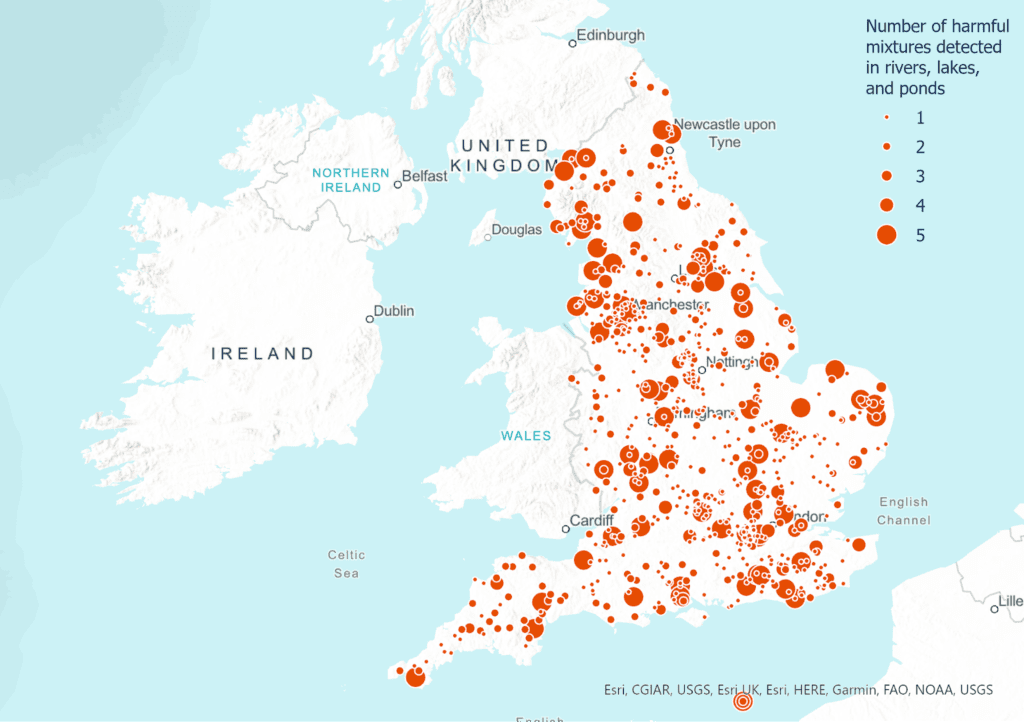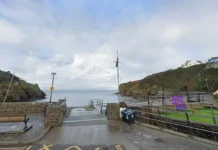New analysis of official Environment Agency data has revealed the worrying scale of chemical cocktail pollution in rivers and other freshwater sites across England.[1] The research, which looked at the prevalence of 5 chemical cocktails known to have toxic impacts for wildlife, also highlights the lack of official monitoring for known harmful chemical cocktails, as well as the lack of a regulatory framework to address these mixtures.
Findings from Wildlife and Countryside Link and The Rivers Trust reveal that:
- Chemical cocktails, that have been proven harmful to wildlife in scientific studies, have been found in 814 river and lake sites (out of 1,006 sites with data – 81% ) and 805 groundwater sites (out of 1,086 sites with data – 74%) across England
- Over half (54%) of these sites contained 3 or more of the 5 harmful chemical cocktails investigated [2]
- Up to 101 chemicals were identified in river samples, with sites along the rivers Mersey, Stour, Colne, Thames, Trent, Yare, Irwell, Medway, Humber and Avon among those containing the highest numbers of chemicals. The actual numbers of chemical pollutants will be even higher [3]
The chemical cocktails found across the 1,619 sites contained six different chemicals in 5 different hazardous mixtures. These included four toxic forever chemicals PFOS, PFOA, PFBS and PFHxS, the pesticide 2,4-D and the commonly used painkiller ibuprofen (see table below for more detail). In specific combinations these chemicals are known to have increased harmful impacts on a range of species including amphibians, fish, insects, nitrogen-fixing bacteria and algae. Identified detrimental effects included reduced growth, cell function, impacts on embryos and lower survival rates. Any potential human health implications, for example through contact via bathing or recreation, remain unknown.
Some of the sites where all five chemical cocktails were found include: The Chelt (in Cheltenham); The Derwent (in Yorkshire); The Trent (in Staffordshire); The Exe (in Devon); The Ouse (in Lewes East Sussex); the Wansbeck (in Northumberland); and the Yare (in Norfolk).
A group of charities, including Wildlife and Countryside Link, The Rivers Trust, Surfers Against Sewage, Buglife, WildFish, Fidra, Pesticide Action Network UK, The Wildlife Trusts, The National Trust, Whale and Dolphin Conservation and the Pesticide Collaboration, are launching a ‘Chemical Cocktail Campaign’ today, urging the Government to take a much more ambitious approach to regulating harmful chemicals. [4] Their calls include asking Government to include in its forthcoming UK Chemicals Strategy: regular monitoring for chemical cocktails in rivers, and new legal protections against dangerous chemical cocktails, including requiring assessments of potential hazardous chemical mixture impacts before any new chemical is allowed on the market.
Richard Benwell, CEO of Wildlife and Countryside Link, said: “A harmful chemical cocktail is being stirred up in UK rivers, putting wildlife and public health at risk. Government regulates and monitors chemicals individually, ignoring the cocktail effect. But our research shows that toxic combinations of pesticides, pharmaceuticals and forever chemicals are polluting rivers up and down the country. The new Chemicals Strategy must make sure harmful substances are regulated not just for individual risks, but for their effects in combination.”
Rob Collins, Director of Policy and Science at the Rivers Trust, said: “We need to stop pumping poison into our rivers. Hazardous chemicals are flowing into our waters, derived from every aspect of our lives. On the small-scale from the toiletries, food packaging, clothing and other goods we use individually, to large-scale industrial, medical and food production, we are creating an ever-growing chemical cocktail in our rivers. The fact that these known toxic chemical combinations are found so widely across the country is deeply worrying. And that’s just the tip of the iceberg. Unless we act now we’ll see increasingly contaminated water, less wildlife in our rivers and ocean, and this raises implications for human health as well.”
Ellen Bradley, Co-Director of UK Youth For Nature, said: “The chemical cocktail in our rivers is a recipe for disaster for nature and future generations. Everything from the clothes we wear to the medicines we use plays a part in the problem. Even the food we eat everyday is part of a broken system that is choking our rivers with harmful chemicals and leaving UK wildlife paying the price. Tougher chemical controls and curbs on agricultural pollution are vital if younger people are to see our not so freshwater cleaned up in their lifetimes.”
Please see additional quotes from Ruth Jones MP and the Rt Hon Philip Dunne MP below the maps and from Fidra and The Wildlife Trusts in the notes to editors [5]
A range of five known toxic chemical cocktails was looked for in Environment Agency data. While there are other known toxic combinations (and likely many more unknown) a narrow focus was used due to the volume of data that needed to be reviewed. All of the chemical combinations focused on cocktail impacts with the harmful and extremely prevalent forever chemicals perfluorooctane sulfonate (PFOS) and perfluorooctanoate (PFOA) . These were chosen due to how widespread they are (despite having been banned) and the need for them to be recorded under Water Framework Directive requirements, making them more visible chemical contaminants for assessment.
The following table details the toxic chemical cocktails that were investigated and the number of sites they were discovered at. Alongside this, are details of the studies that have identified harm to wildlife species from these harmful chemical combinations. Please note that all of these studies were carried out in laboratory conditions, not in the field.
The levels of these contaminants in rivers were typically much lower than in the laboratory studies, but individually, each of these chemicals are known to impact wildlife at concentrations lower than those reported in these studies. In addition it is not known how these chemical cocktails (which are binary mixtures studied in the laboratory) interact with other chemicals in a wider mixture in our rivers. [6] Their widespread presence in our rivers, knowing their damaging impacts in laboratory studies, is cause for concern.
Table 1: Chemical cocktails identified in English river sites
| Chemicals | What are these chemicals? | Proven impact | TOTAL number of site detections | Number of river and lake site detections | Number of ground- water site detections |
| perfluorooctane sulfonate (PFOS) + perfluorooctanoate (PFOA) | PFOS and PFOA belong to a large family of over 10,000 substances known as PFAS. PFOS is banned in the UK, and PFOA has mostly been phased out by industry, but both continue to persist and be very prevalent in our waters. PFAS can repel both grease and water leading to their use in a wide variety of products e.g. food packaging, cleaning products, toiletries, clothes and furniture. | Shown to inhibit connective tissue cell activity in amphibians in Hoover et al study 2019. And to negatively impact Zebrafish embryo growth in Ding et al study 2012. | 1113 | 811 | 302 |
| perfluorooctane sulfonate (PFOS) +2,4-D | PFOS belongs to the PFAS family (as detailed above)2, 4-D is a pesticide which was widely used to kill broad leaf weeds. It is now banned in the UK. | Mixture proven toxic to Anabaena, a nitrogen-fixing bacteria, helpful for plant growth, in Rodea-Palomares et al study 2012. | 417 | 314 | 103 |
| perfluorooctane sulfonate (PFOS) + Perfluorobutane sulfonic acid (PFBS) | PFOS(banned) and PFBS belong to the PFAS family.PFBS – while very similar to PFOS – is still allowed for use in a range of household and consumer items e.g. cleaning products. | Inhibits growth of algae and damages its ability to perform photosynthesis. Shown in Zhang et al study 2023. | 885 | 113 | 772 |
| Ibuprofen +perfluorooctanoate (PFOA) | PFOA belongs to the PFAS familyIbuprofen is an anti-inflamatory pain relief medication, widely sold and used in the UK. | Mixtures of PFOA and ibuprofen inhibited the growth of the microalga P. subcapitata in Gonzalez-Naranjo & Boltes study 2014. | 81 | 81 | 0 |
| perfluorooctane sulfonate (PFOS) +Perfluorohexane sulfonate (PFHxS) | PFOS and PFHxS belong to the PFAS family, both are banned in the UK. | Showed reduced survival in midges McCarthy et al 2021 | 881 | 108 | 773 |
Map 1: River, lake and pond sites in England where 1 or more of the 5 chemical cocktails were found

Map 2: Groundwater sites across England where one or more of the 5 chemical cocktails were found
JPEG copies of both maps can be found here.
Table 2: Number of chemical cocktails present at river, lake and groundwater sites across England
| No. of chemical cocktails present | 1 | 2 | 3 | 4 | 5 |
| No. of river, lake and groundwater sites | 493 | 242 | 701 | 112 | 69 |
| No. of river and lake sites only | 480 | 223 | 12 | 30 | 69 |
| No. of groundwater sites only | 13 | 21 | 689 | 82 | 0 |
Speaking at a Parliamentary event on chemical cocktail pollution yesterday (23 May), hosted by UK Youth For Nature and Wildlife and Countryside Link, the Rt Hon Philip Dunne MP, Chair of the UK Parliament Environmental Audit Committee, said: “The country’s precious waterways should be as free from pollutants as possible, yet the long-standing prevalence of harmful chemicals has meant that no river in England is in good chemical health. How these chemicals interact with each other could be deadly to creatures living in freshwater habitats.
“During the course of the Committee’s inquiry examining water quality of rivers, we were alarmed at the lack of monitoring taking place for harmful pollutants, including chemicals. We must know what we’re tackling, so monitoring and assessment is absolutely critical. The Committee concluded that annual chemical assessments should take place.
“These findings are a timely reminder that the chemical cocktail in inland waters is affecting every corner of the country. It raises concerns about the potential harm to human health and it is leaving destruction of nature in its wake. The Government should build on its plans to improve water quality by having a clear roadmap on how to address the dangerous chemical cocktail coursing through England’s waterways.”
Ruth Jones MP, Shadow Minister (Environment, Food and Rural Affairs), said: “The UK’s current approach on chemical pollution is failing, and these stark statistics are yet more evidence of this. No-one wants to swim in a lake polluted with pesticide, have hidden forever chemicals in our drinking water, or see otters, fish, dragonflies and other wildlife poisoned by toxic chemicals in our waters.
“We need action now to curb the chemical cocktail in our rivers, but it is slow to arrive and disappointing when delivered, such as recent limited proposals on PFAS regulation. The Government must up its game and tackle the sewage pollution scandal and chemical pollution crisis together to give communities and nature the clean water they deserve.”
As well as some chemicals being damaging to wildlife on their own, sometimes when chemicals mix together in the environment, they can cause even more harm to nature. When several chemicals are present together, their toxicity can add up or interact to produce a mixture effect. The most common mixture effect is additional, this is when the toxicity of each chemical adds up, resulting in an adverse effect even when each chemical individually is at a low (“safe”) concentration. In rarer cases it can be antagonistic, resulting in a weaker effect or synergistic, resulting in an even greater effect. The above combinations searched for in our research are synergistic – causing multiple times the harm of the individual components.
Far too little is known about the impact of chemical cocktails on wildlife and people. It would not be economically feasible to specifically assess and regulate all of the vast number of possible chemical combinations. But we do need to deliver additional safeguards to reduce the risk of creating dangerous chemical cocktails in our rivers.
To tackle the chemical cocktail affecting our waters and wildlife, measures are needed which reduce the number and amount of chemicals used in our daily lives and which are released into the environment. We also need much greater understanding, monitoring and prevention of chemical cocktails at a Government regulatory level. Key actions nature organisations are calling for in the upcoming UK Chemicals Strategy include:
– Phasing out known toxic chemicals (including PFAS forever chemicals) from all but the most vital uses.
– Regulating chemicals in groups (where all chemicals with similar structures would be restricted if one was found to be harmful. Preventing one damaging chemical being easily replaced by another similar chemical).
– Specific measures to address the chemical cocktail effect in our rivers and ocean through: introducing a requirement to assess possible interactions with other chemicals before any new chemical is allowed on the market; greater research into chemical cocktail impacts for wildlife and human health; and routine monitoring of waters for known dangerous combinations of cocktails.
– Delivering more rigorous monitoring for chemical pollutants more widely, including through increased funding for the Environment Agency’s river monitoring programme.
Members of the public are being encouraged to sign a joint letter to the Secretary of State,Thérèse Coffey, to demand action on chemical pollution: bit.ly/chemical-cocktail
Help keep news FREE for our readers
Supporting your local community newspaper/online news outlet is crucial now more than ever. If you believe in independent journalism, then consider making a valuable contribution by making a one-time or monthly donation. We operate in rural areas where providing unbiased news can be challenging. Read More About Supporting The West Wales Chronicle
























